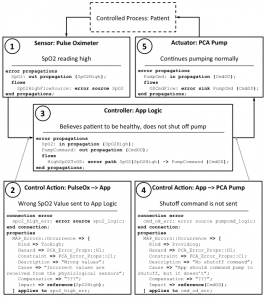
A few months ago, I wrote about my recent work on defining a subset of the language AADL to specify the architecture of bits of software (apps) that would run on medical application platforms (MAPs). Since then, I’ve been working on how developers can use these semi-formal architectural descriptions to do useful things. The first “useful thing” is integrating hazard analysis annotations with these architectural descriptions — that is, specifying how things could go wrong in the app.
Structured hazard analyses have been performed for over half a century now (some dating back to the late 1940s!) but in some ways are still the same as they were back then, in that they are still unintegrated with the system under analysis — that is, any analysis performed would live in a separate document (often a Word file). In programming terms, this would be like having a system’s documentation be separate from the implementation, which isn’t nearly as useful as techniques like Doxygen or Javadoc, where everything is more tightly integrated.
So, after looking at a number of hazard analysis techniques, I (and others my research lab) settled on the relatively new, systems-focused Systems Theoretic Process Analysis (STPA). From there, we looked at tailoring it to the medical application development process, and how that tailored process could be integrated with the architecture specifications from our previous work. The result of this effort was a paper, which was recently accepted to the 2014 ACM-IEEE International Conference on Formal Methods and Models for System Design (MEMOCODE) in Lausanne, Switzerland. I’m really excited to go and present.
My advisor has described the paper as “incredibly dense” (I blame page limits.) so in the next few months I’ll be expanding it into a whitepaper that will hopefully be much clearer, and will be of use to our research partners in regulatory agencies.
Leave a Reply to Ben West Cancel reply